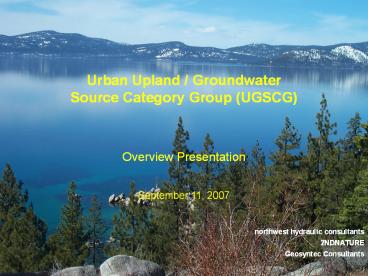northwest hydraulic consultants
Title:
northwest hydraulic consultants
Description:
Inform pollutant load reduction estimates for urban storm water runoff, ... Rain Barrel. Permeable. Pavement. Multiple BMPs. PCO. Etc. HSC-3 ... –
Number of Views:30
Avg rating:3.0/5.0
Title: northwest hydraulic consultants
1
Urban Upland / Groundwater Source Category Group
(UGSCG)
Overview Presentation
September 11, 2007
- northwest hydraulic consultants
- 2NDNATURE
- Geosyntec Consultants
2
Purpose and Background
- Inform pollutant load reduction estimates for
urban storm water runoff, including infiltration
to groundwater - Watershed Model simulations use UGSCG input to
estimate pollutant load reductions for surface
water - Groundwater estimates conducted independent of
Watershed Model simulations
Overview Presentation
UGSCG September 11, 2007
3
Key Steps in Approach(Surface Runoff)
- Step 1 PCO Evaluation
- Step 2 Site-Scale Analysis
- Define Urban Upland Settings
- Develop Treatment Tiers by Setting
- Step 3 Basin-Wide Analysis
- Provide input to Watershed Model
- Watershed Model simulations estimate pollutant
load reductions
Overview Presentation
UGSCG September 11, 2007
4
PCO Considerations
- Large number of BMPs are applicable to urban
uplands and groundwater - BMPs are typically applied in various
combinations, configurations, and sizes depending
on site conditions - Potentially creates an unmanageable number of
alternatives
Overview Presentation
UGSCG September 11, 2007
5
PCO Development
A single PCO represents multiple BMPs having
similar function and process
Overview Presentation
UGSCG September 11, 2007
6
PCO Performance Estimates
- PCOs categorized to estimate performance
HSC
PSC
SWT
Overview Presentation
UGSCG September 11, 2007
7
PCO Performance Estimates (cont.)
- Pollutant Source Controls
- Represented by adjustments to existing condition
EMCs by land use - Tahoe Basin storm water data and other applicable
data applied - Aggregation of multiple BMPs improves land use
condition - Best professional judgment applied
Overview Presentation
UGSCG September 11, 2007
8
PCO Performance Estimates (cont.)
- Hydrologic Source Control
- Specified storage volume and infiltration rate
- Capture ratios computed
- Storm Water Treatment
- Median effluent quality from Tahoe storm water
monitoring data and ASCE database - Capture ratios computed
Overview Presentation
UGSCG September 11, 2007
9
Urban Upland Settings
- Settings classify subwatersheds to guide
potential PCO applications - Settings based on two key physiographic
characteristics - Impervious area configuration
- Average slope of urban area
- Many other performance factors captured by
Watershed Model (e.g., meteorology, land use,
soils, etc.)
Overview Presentation
UGSCG September 11, 2007
10
Urban Upland Settings
- 4 Settings defined
- Concentrated-Steep
- Concentrated-Moderate
- Dispersed-Steep
- Dispersed-Moderate
- Settings recognized to not represent project
implementation scale
Overview Presentation
UGSCG September 11, 2007
11
Treatment Tiers
- Conceptual combinations of PCOs applicable to a
particular Setting - Two standard Treatment Tiers defined
- Represent steps or levels in expected water
quality performance and cost - Tier 1 Similar to existing practice
- Tier 2 Tier 1 plus increased spatial scale of
PCO implementation and more advanced PCOs applied
Overview Presentation
UGSCG September 11, 2007
12
Treatment Tier Example
Overview Presentation
UGSCG September 11, 2007
13
Pump and Treat Tier
- Developed specialized treatment tier
- Collection and pumping of storm water to a
regional treatment plant - Applied in concentrated settings
Overview Presentation
UGSCG September 11, 2007
14
PCO Performance Informing Watershed Model
Simulations
Overview Presentation
UGSCG September 11, 2007
15
Preliminary Results (Surface Water)
Estimated Average Annual Load Reduction (Metric
Tons)
Overview Presentation
UGSCG September 11, 2007
16
Groundwater Background
- Key question
- What is the impact of urban storm water
infiltration on groundwater nutrient loading to
the Lake? - Estimated changes to groundwater loads
independent of Watershed Model - Baseline conditions assumed from Groundwater
Framework Study for Lake Tahoe (ACOE 2003) - Mass balance approach used
Overview Presentation
UGSCG September 11, 2007
17
Key Steps in Approach(Groundwater)
- SWMM used to quantify infiltrated volumes
- Compared and related SWMM results to ACOE (2003)
for baseline conditions - Used SWMM to estimate changes in infiltrated
volumes for Tier 1 and Tier 2 implementation - Applied estimates of Tier 1 and Tier 2
characteristic runoff quality infiltrated - Developed estimates of pollutant loads to
groundwater
Overview Presentation
UGSCG September 11, 2007
18
Preliminary Results (Groundwater)
Overview Presentation
UGSCG September 11, 2007































